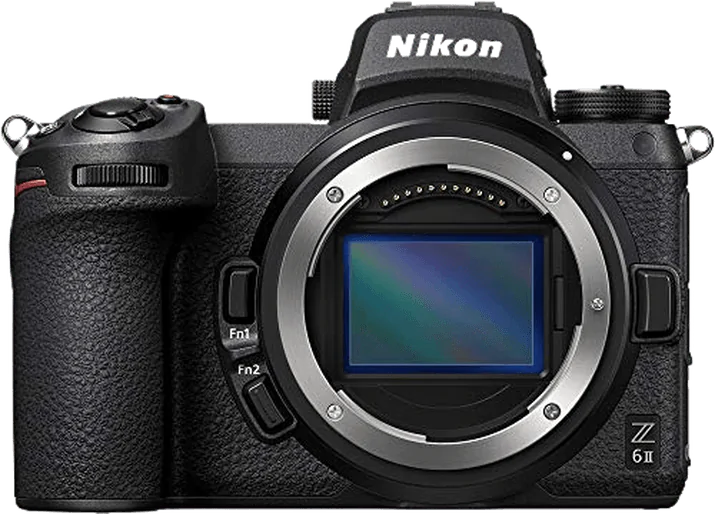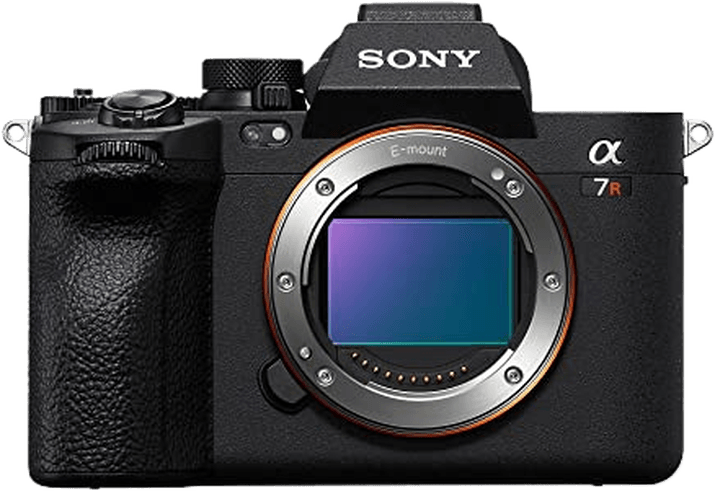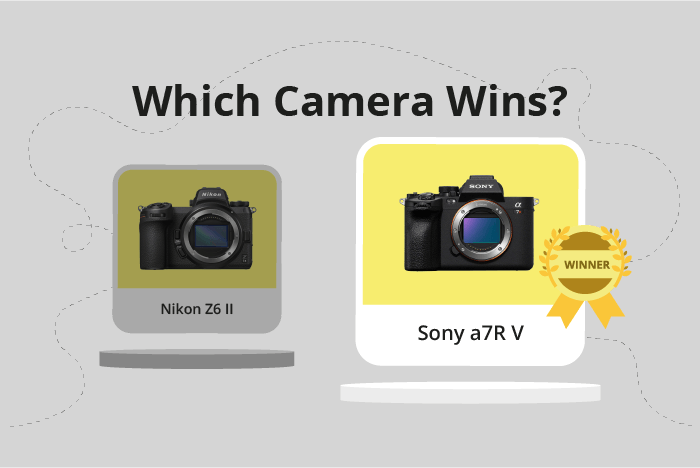Nikon Z6 II vs Sony a7R V Comparison
Nikon Z6 II

Sony a7R V

The Sony a7R V outperforms the Nikon Z6 II with a score of 85/100 compared to 83/100. Both cameras are mirrorless and have similar dimensions, with the Nikon Z6 II measuring 134 x 101 x 70mm and weighing 705g, while the Sony a7R V measures 131 x 97 x 82mm and weighs 723g.
The Sony a7R V excels with its higher score, reflecting its superior performance and features. On the other hand, the Nikon Z6 II has the advantage of a lower launch price at $1995 compared to the Sony a7R V’s $3999. This makes the Nikon Z6 II a more affordable option for photographers on a budget.
Taking these factors into account, the Sony a7R V is the better camera in terms of performance, while the Nikon Z6 II offers a more budget-friendly option without significantly compromising on quality.
Nikon Z6 II vs Sony a7R V Overview and Optics
The Sony a7R V takes the lead with a score of 85/100 in optics, outperforming the Nikon Z6 II, which scores 83/100. Both cameras share some common specifications, including a CMOS sensor, full-frame sensor size, and image stabilization. They also have the same DXOMARK score of 94 for their sensors.
The Sony a7R V excels in its higher megapixel count, boasting 61 megapixels compared to the Nikon Z6 II’s 24.5 megapixels. This difference allows the Sony a7R V to capture more detail and produce higher resolution images. Additionally, the Sony a7R V features a Bionz XR processor, which contributes to its superior performance in optics.
On the other hand, the Nikon Z6 II has a faster shooting speed of 14 frames per second compared to the Sony a7R V’s 10 frames per second. This advantage makes the Nikon Z6 II more suitable for capturing fast-moving subjects or shooting in burst mode. The Nikon Z6 II also comes with a dual Expeed 6 processor that ensures efficient performance.
Both cameras have their respective lens mounts, with the Nikon Z6 II using the Nikon Z mount and the Sony a7R V using the Sony FE mount. This aspect depends on the user’s preference and existing lens collection.
The Sony a7R V’s higher score reflects its superior image quality and resolution, making it an ideal choice for photographers seeking top-notch image output. However, the Nikon Z6 II’s faster shooting speed may appeal to those who prioritize capturing fast action or continuous shots. Ultimately, the choice between the two cameras depends on the user’s specific needs and preferences.
Nikon Z6 II vs Sony a7R V Video Performance
The Sony a7R V outperforms the Nikon Z6 II in video capabilities with a video score of 100/100, compared to Nikon’s 91/100. Both cameras share key features like a maximum video frame rate of 120fps and built-in time-lapse functionality. However, the Sony a7R V’s superior video specifications make it the clear winner in this comparison.
The primary advantage of the Sony a7R V is its 8K max video resolution, offering 7680 x 4320 video dimensions. This is a significant improvement over the Nikon Z6 II, which has a maximum video resolution of 4K, with 3840 x 2160 video dimensions. The higher resolution of the Sony a7R V allows for more detailed and sharper video footage, enhancing the overall quality of the output.
While the Nikon Z6 II falls short in video resolution, it still offers competitive video capabilities. With its 4K resolution and 120fps frame rate, it can capture high-quality video footage suitable for various professional and personal uses. However, it is important to note that it does not match the Sony a7R V’s 8K resolution.
The comparison between the Nikon Z6 II and the Sony a7R V reveals that the Sony a7R V is the superior camera in terms of video capabilities, thanks to its 8K resolution. The Nikon Z6 II remains a strong contender with its 4K resolution, but it cannot compete with the higher resolution offered by the Sony a7R V. For those seeking the best video quality, the Sony a7R V is the clear choice.
Nikon Z6 II vs Sony a7R V Features and Benefits
The Nikon Z6 II and the Sony a7R V both have a feature score of 87/100, making them equal in this aspect. These cameras share several common features, which include a 3.2-inch screen size, screen resolution of 2,100,000 dots, touchscreen capability, absence of GPS, and the presence of both WIFI and Bluetooth functionality.
The Sony a7R V has an advantage over the Nikon Z6 II with its flip screen feature. This allows for more versatile shooting angles and better composition, especially for self-portraits or vlogging. This additional feature sets the Sony a7R V apart from the Nikon Z6 II in terms of usability and user experience.
On the other hand, the Nikon Z6 II does not offer any significant advantages over the Sony a7R V in terms of features. Both cameras have the same score and share almost identical specifications. The lack of a flip screen on the Nikon Z6 II may be a drawback for some users, but it does not make it an inferior camera overall.
Comparing the two cameras, it is evident that the Sony a7R V has an edge over the Nikon Z6 II, mainly due to the flip screen feature. However, both cameras have the same feature score and share several identical specifications, making them equally strong contenders in the market. Users should consider their individual needs and preferences when choosing between these two cameras, as the difference in features may not be significant enough to impact the overall performance and image quality.
Nikon Z6 II vs Sony a7R V Storage and Battery
The Sony a7R V wins in the storage and battery category with a score of 73/100, while the Nikon Z6 II scores 71/100. Both cameras have two memory card slots and support USB charging. The Nikon Z6 II accepts SD, CFexpress Type B / XQD (UHS-II compatible) cards, while the Sony a7R V takes SD / SDHC / SDXC and CFexpress Type A cards.
The Sony a7R V outperforms the Nikon Z6 II in battery life, offering 530 shots per charge, compared to the Nikon’s 410 shots. The a7R V uses the NP-FZ100 battery, while the Z6 II relies on the EN-EL15c battery.
The Nikon Z6 II has an advantage in terms of memory card compatibility, as it accepts both CFexpress Type B / XQD and UHS-II compatible SD cards, offering more flexibility for photographers.
Both cameras excel in storage and battery, with the Sony a7R V taking a slight lead due to its longer battery life. The Nikon Z6 II, however, offers broader memory card compatibility, making it a strong contender as well.
Nikon Z6 II vs Sony a7R V – Our Verdict
Are you still undecided about which camera is right for you? Have a look at these popular comparisons that feature the Nikon Z6 II or the Sony a7R V:

